Australia - New South Wales
Posted - May 19 2009
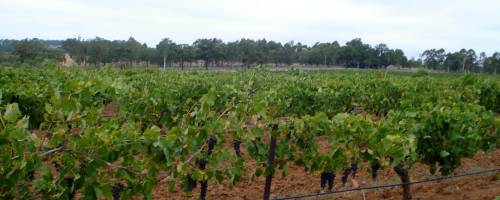
The Graveyard Vineyard in Hunter Valley NSW
Located in the southeastern
portion of the great island continent of Australia and home to the stunning
harbor city of Sydney, is New South Wales. However, NSW is not necessarily,
foremost in consideration of international wine drinkers. Yet it's here that the
first vines, brought to Australia were planted, in Sydney, and it’s also here,
just two hours drive north, the historic Hunter Valley lies.
Hunter Valley became a wine
region based on its proximity to Sydney – not due to its perfect growing
conditions. A flat valley in the Brokenback Range (the coastal mountain range)
Hunter Valley is, without question a beautiful destination and is a favorite
weekend destination of Sydneysiders. Ironically, this is traditionally a mining
region. And, there is a fairly obvious disparity between the perceived prestige
of the wine industry (and those who travel to wine regions to enjoy the finer
things in life) and the understated blue-collar locals.
Although its one of the warmest (and most
humid) wine regions in Australia the significant amount of rain it receives
falls during the growing/harvesting season - sometimes causes dire repercussions.
I arrived just after the Semillon had been harvested in early
February. That night the rain started and didn't let up. I heard it was still
raining almost a week later.
Brokenwood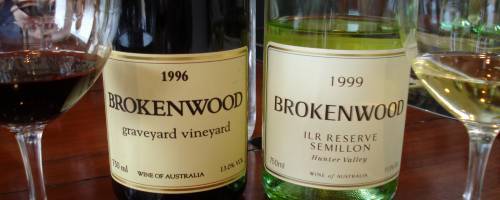
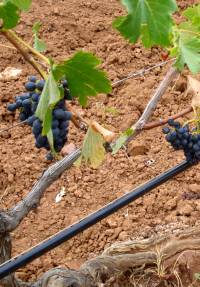 After
being picked up by Brokenwood General Manager (and one of its 23 partners),
Geoff Krieger in Sydney we drove north, into this verdant coastal range until we
rolled into the town of Cessnock then continued north along Highway 82, also
known as Wine Country Drive. By the time we passed the legendary Lovedale
Vineyard there was no doubt we were in wine country as row upon row of vines
painted the horizon. Turning onto Broke Road, then MacDonald Road we made a
brief stop in the Graveyard Vineyard to taste the berries before taking the back
way into my first Hunter Valley stop, the highly acclaimed Brokenwood winery.
After
being picked up by Brokenwood General Manager (and one of its 23 partners),
Geoff Krieger in Sydney we drove north, into this verdant coastal range until we
rolled into the town of Cessnock then continued north along Highway 82, also
known as Wine Country Drive. By the time we passed the legendary Lovedale
Vineyard there was no doubt we were in wine country as row upon row of vines
painted the horizon. Turning onto Broke Road, then MacDonald Road we made a
brief stop in the Graveyard Vineyard to taste the berries before taking the back
way into my first Hunter Valley stop, the highly acclaimed Brokenwood winery.
A combination of
dance and reggae music was pounding out of the winery where a handful of young,
Blundstone shod, apprentice winemakers from around the world labored on the 2009
vintage. Semillon was fermenting in stainless steel tanks
and the presses were rolling out discarded Semillon
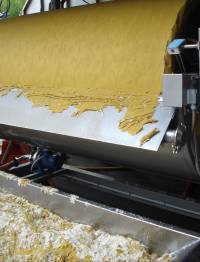 skins
into golden sheets.
skins
into golden sheets.
I sat down with Chief Winemaker Iain ‘Riggsy” Riggs to taste a selection of what
makes the Hunter Valley (and Brokenwood) famous – Semillon – plus a trio of
Shirazes. Riggs is not only well-known but also very well respected winemaker
and wine judge in Australia. He is also the successor to Len Evans as the
Chairman of the Hunter Valley Wine Show and makes a mean Semillon. Working
alongside Riggs is young Kiwi winemaker P.J. Charteris. P.J. seems to be the one
who keeps an eye on the motley crew of winemaking trainees, he looks as though
he could be one of them.
I spent the better part of
morning with the Brokenwood team, until the lunch bell rang I sat down to a
delicious, healthy, buffet-style lunch prepared by an in-house chef,
specifically to feed the crew and
keep their energy levels up.
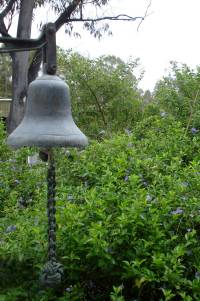
Even better were the bottles
of wine, shared around this picnic table with lunch – a tasty glass of wine with
lunch – very civilized.
Brokenwood wines can be found in some markets in Canada.
Brokenwood Semillon,
Hunter Valley, 2008 has creamy sweet citrus and gooseberry with snap peas,
minerals and herbal tones. Taut, snappy acidity with loads of lemon/lime and
zesty flavours.
Brokenwood Semillon
Oakey Creek Vineyard, Hunter Valley, 2004 has interesting toasty, honey and
brown sugar notes with undertones of minerals. The palate has a lovely rounded
texture with lime citrus and honey flavours and a crisp, clean finish.
Brokenwood
Semillon Stanley Park, Hunter Valley, 2007
has gorgeous, bright fruit – apple and pear, passion fruit and honey with lovely
floral tones.
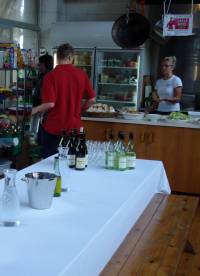
On the palate it’s a gorgeous balance of crisp and creamy with flavours of
citrus, honeycomb and figs. Delicious
Brokenwood Semillon ILR
Reserve, Hunter Valley, 2003 ILR stands for its maker….Ian Lesley Riggs. The
aromas are smoky, sweet – caramelized figs, vanilla praline. It has ripe creamy
fruit, citrus peel and toasty flavours on the palate - very elegant.
Brokenwood Semillon ILR
Reserve, Hunter Valley, 1999 shows aromas of asparagus and honey, roasted
figs, and honeycomb. Smooth and creamy on the entry with flavours of brown
butter and sage and a long citrus finish – clean and bright.
Brokenwood Shiraz Hunter
Valley, 2007 shows briary fruit, blackberries, dark chocolate and leather
with hints of dill and green olive. It’s somewhat austere on the palate with
fine dusty tannins throughout,
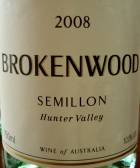
earthy, leathery hints and a dry finish.
Brokenwood Shiraz McLaren,
Hunter, Beechworth, 2006 is primarily McLaren Vale fruit and presents sweet
cherry, warm spice, crushed dark floral tones and hints of dried fruit. Great
acidity on the palate with creamy plums, black cherries, dark chocolate shavings
and fine, firm tannins.
Brokenwood Shiraz
Graveyard Vineyard, Hunter Valley, 2006 is an elegant Shiraz from
Brokenwood’s darling, the Graveyard Vineyards next to the winery. This icon
Shiraz shows primary cherry aromas followed with espresso and mixed berries.
The palate is smooth with harnessed power, spice tobacco
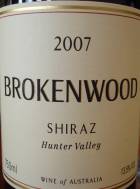
and leather. The tannins are ripe and the finish is bittersweet.
Brokenwood Shiraz Graveyard
Vineyard, Hunter Valley, 1996 has youthful, bright berry/cherry aromas,
leather and savoury/meaty tones with hints of celery salt. Like the 2006,
old-world elegance is noticeable, complex with fine peppery spice and silky
tannins.
for more information on
Brokenwood click here
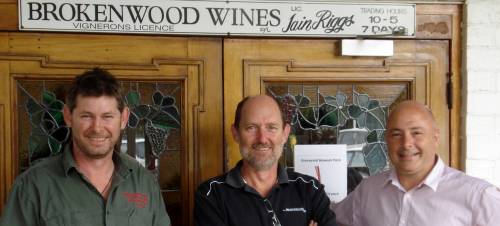
Brokenwood trio - winemaker P.J.
Charteris, Chief winemaker Iain Riggs, partner Geoff Krieger
Hungerford Hill
Hungerford Hill tasting room and cellar
door

Hungerford Hill is a
landmark building in the Hunter. An architectural winery across from the
Lovedale Vineyard and the tiny Cessnock airport and just down the road from the
Hunter Valley visitor’s center it was one of the first buildings I saw when I
drove into the region. Although Hungerford Hill was established in 1969, the
current owner James Kirby had this new winery built in 2003, complete with a
beautiful, modern restaurant and tasting room.
During my visit, the restaurant was
under a change of chef and management so I was unable to dine there, but I look
forward to returning and checking out the new, Muse.
Like Brokenwood, Hungerford
Hill had already harvested Semillon. But unlike the controlled wildness at
Brokenwood it was a quiet evening when I tasted the Semillon ferments with
winemaker Michael Hatcher
(right)
at Hungerford Hill.
Hatcher gave me a tour of the winery before we
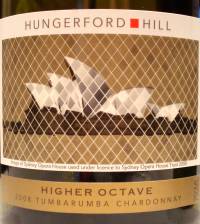
headed up to the tasting room. It was here that I discovered a region I had
never (as with many outside of Australia) heard of - Tumbarumba. Although
Hungerford Hill is a proudly Hunter Valley winery, like many in the region they
source fruit from other wine regions around Australia. Hatcher has been enamored
of the cool climate Tumbarumba fruit from his days back in Waga Waga, the
oenology school in southern NSW. Although Tumbarumba is a newly recognized
winegrowing region (vines were first planted three decades ago) its mountainous
cool-climate terroir is creating a lot of interest.
*You can read more about this winegrowing region and other cool-climate Oz
regions in my article in the July/August 2009 issue of Vines Magazine.
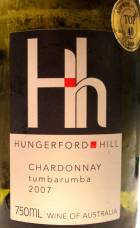
Hungerford
Hill relies on the pristine fruit from Tumbarumba for some of its regional and
icon series wines as well as grapes from South Australia - Adelaide Hills,
Coonawarra and Barossa as well as New South Wales regions – Orange and Hilltops.
But the wines you may recognize in Canada are the Fishcage Series wines.
A selection of Hungerford Hills wines are available in Canada, the Fishcage
series are available in BCLDB stores.
Hungerford Hill Sauvignon
Blanc, Tumbarumba, 2008 has very pretty, pleasing aromatics – orchard
blossoms, white fruits and citrus. There is a kiss of sweetness on the palate
and is fresh, easy drinking wine with a crisp finish.
Hungerford Hill Semillon,
Hunter Valley, 2008 shows snappy white fruit, jalapeno and sweet citrus with
hints of spring blossoms and cut grass. The palate is lovely and zingy fresh
with loads of citrus peel flavours.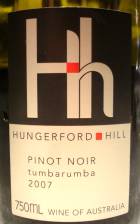
Hungerford Hill Chardonnay,
Tumbarumba, 2007 although this Chardonnay sees oak, there is no malo-lactic
fermentation and shows crisp white fruit, hints of caramel and warm spices with
plenty of minerality showing through. Good oak balance.
Hungerford Hill
“Higher Octave” Chardonnay, Tumbarumba, 2008 is superbly fresh with
alluring, creamy caramel, sweet spices with loads of juicy fruit and citrus.
It’s elegant and complex and with a deft use of oak. Previously made from
Adelaide Hills fruit Hatcher now sources the grapes for this wine from
Tumbarumba.
Hungerford Hill Pinot Noir,
Tumbarumba, 2007 there is good intensity of aromas here – bright cherry,
cranberry and raspberry
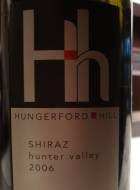 aromas,
sweet spices and dark floral notes. The palate is silky it has very good
structure with juicy red fruit, spice and cedar flavours, there are fine tannins
on the finish.
aromas,
sweet spices and dark floral notes. The palate is silky it has very good
structure with juicy red fruit, spice and cedar flavours, there are fine tannins
on the finish.
Hungerford Hill Shiraz, Hunter Valley,
2006 There are plush, fragrant aromas of blueberry and cherry fruit
with warm spice. The acidity is lovely and lifts the fruit, while the earthy,
chocolate flavours anchor it, the tannins are fine and dry.
Very good.
Hungerford Hill Cabernet Sauvignon,
Hilltops, 2006 – Hilltops is a region close to Tumbarumba in southern New
South Wales.
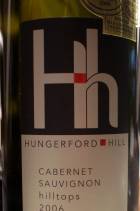
This particular vineyard is 600m above sea level. It features bright, cassis and
hints of chocolate with lifted eucalypt/green olive aromas and just a touch of
blueberry on the nose. The palate is sweet and ripe, supple and brimming with
berry fruit – the tannins are fine and lingering, the finish dry.
Link to previous reviews Hungerford Hill:
Fishcage Chardonnay~Viognier 2006
here
Fishcage Shiraz~Viognier 2005
here
For more information on Hungerford Hill
click here
McWilliam's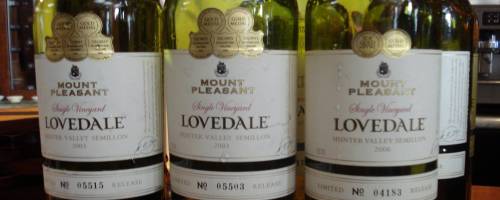
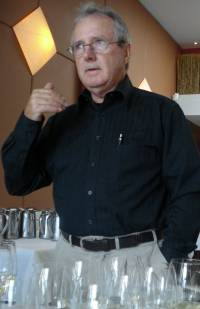
McWilliams is, without doubt one of Australia's
most recognized names.
And, with 130 years behind them it's a well earned designation. McWilliams has
vineyards all over Australia - in Hunter Valley, Riverina and Hilltops in NSW;
Margaret River in Western Australia; Yarra Valley in Victoria and Coonawarra in
South Australia. Hunter Valley's Mount Pleasant is of course the most important,
here is where the venerable Lovedale Vineyard is located. Mount Pleasant is a
lovely location on a grassy knoll on Marrowbone Road not far from the Lovedale
Vineyard. Lovedale, planted in 1946 by celebrated winemaker Maurice O'Shea, is
said to produce the best Semillon wines in Australia and possibly, the world.
But for the last 30 years the McWilliam's Mount Pleasant wines (including
Lovedale) have fallen under the custody of Phil Ryan.
(right)
McWilliam's Greg West toured me through the mostly Semilllon planted Lovedale
Vineyard, we talked about its sandy, loam soils and history before heading back
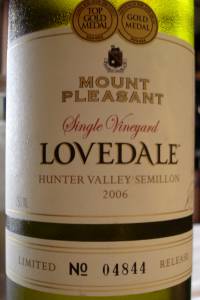
to Mount Pleasant to taste. In a twist of irony I missed Phil Ryan during my
visit but met him two months later in Vancouver.
It was at both Brokenwood and Mount Pleasant I began to realize the iconic
status of Semillon from Hunter Valley, and that they truly are wine-geek wines.
These are wines that have such unique qualities, bracing acidity and tart,
pristine aromas (often confused with Riesling or Sauvignon Blanc) when they are
young and toasty, figgy, honeyed aromas as they age. And Semillons will last
decades. These are wines that need to be cellared, thoughtful, revered wines
those of us in Canada rarely see, and if we do, sadly, we don't really
understand them.
The McWilliams Hanwood Estate and Mount Pleasant wines are available in
select markets in Canada.
McWilliam's Mount Pleasant Lovedale
Semillon, 2000 interesting cut grass and lemongrass, hints of spice and
toast. A gorgeous texture, supple and weighty with grassy, citric and herbal
flavours with a toasty, nutty linger.
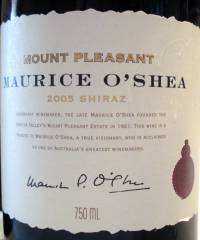
McWilliam's Mount Pleasant
Lovedale Semillon, 2001 the aromas here are somewhat closed but suggest
sweet honey, candle wax and citrus aromas. There are nutty flavours on the
palate, a supple texture and tart, crisp finish.
McWilliam's Mount Pleasant
Lovedale Semillon, 2003 The 2003 vintage is the current release of this
wine. Its more earthy than the other vintages, smoke, toasty/nutty, honeycomb,
some mushroomy/forest floor and citrus. Creamy, soft and nutty on the palate
with citrus peel and honey flavours and a very long finish.
McWilliam's Mount Pleasant
Lovedale Semillon, 2005 like 2006, 2005 was a hot vintage. The aromas here
are surprisingly vibrant - loads of juicy green apple and lemon with grapefruit.
A creamy, oily texture on the palate - loads of body.
McWilliam's Mount Pleasant
Lovedale Semillon, 2006 shows 'oily' aromas, lime and citrus blossom aromas
with figgy, honeyed tones and just a hint of toast. Crisp citric, gooseberry and
mineral flavours. 2006 was a very hot year...
McWilliam's Mount Pleasant
Lovedale Semillon, 2007 the aromas on the 2007 are very waxy, lemon zest and
lime oil with exotic/tropical notes and snap peas. The palate is supple with
loads of bright, tart citric flavours and grassy hints but it's still tight.
McWilliam's Mount Pleasant
Lovedale Semillon, 2009 - gorgeous creamy aromas, candle wax and honey,
floral tones with hints of cut grass. Tart on the palate, young and taut with
lip-smacking acidity. This wine won't be released for several more years.
Mount Pleasant "Maurice O'Shea" Shiraz, 2005 combines sweet, dark
fruit and spice, aromatic dried floral and cedar chips with earthy, savoury,
smoked aromas. The palate is elegant, has gobs of spice, dense dark fruit and
brooding power - potent with fine, grippy tannins. A wine that will leave an
impression..
For more information on McWilliams
click here
Wyndham Estate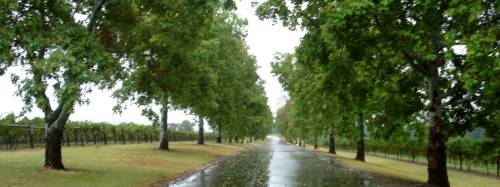
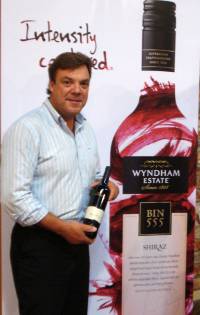 Although
my positive experiences in Australia are to numerous to count, my visit to
Wyndham introduced me to someone who left an amazing impression on me.
Although
my positive experiences in Australia are to numerous to count, my visit to
Wyndham introduced me to someone who left an amazing impression on me.
The rain, which had started the night prior, continued to fall and we were all
wishing we could send it south to drench the fires still devastating Victoria.
A gentleman, by the name of Nigel Dolan picked me up to drive me to the northern
tip of the Hunter, to Wyndham Estate. I didn't know Nigel's history before that
day - he had only recently joined Wyndham and had flown up to the estate from
his home in Barossa to check the status of the vintage. Dolan
(right) had
previously been the winemaker at Saltram in Barossa and had then become chief
red winemaker for the Saltram owned Foster's Group. In fact, Dolan was the eight
generation Dolan to make wine for Saltram, and a wine, named in his (and his
Dolan predecessors) honor called "Eigth Maker" is (was) a tribute to that.
(More on this in an upcoming story on Barossa).
Nigel and I sat down to taste a range of the Wyndham Estate wines, those
made by the previous chief winemaker.
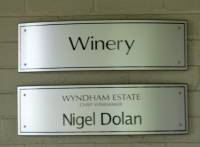 Little
did either of us know, he going to be spending the day with me. As it turned
out, he gave me a lift back to Sydney and we ended up not only on the same
flight, but Nigel was gracious enough to take me into the Qantas Lounge with him
while we waited for out flight to Adelaide. Brave man. But I was happy to spend
the time with him and pick his brain about winemaking in Australia.
Little
did either of us know, he going to be spending the day with me. As it turned
out, he gave me a lift back to Sydney and we ended up not only on the same
flight, but Nigel was gracious enough to take me into the Qantas Lounge with him
while we waited for out flight to Adelaide. Brave man. But I was happy to spend
the time with him and pick his brain about winemaking in Australia.
I truly look forward to meeting him again someday.
Wyndham Estate is sprawling estate set on lush, manicured grounds and was known
as Dalwood wines from 1828 until 1970 when the name was changed to honor the man
who started it all, George Wyndham. Wyndham, a wealthy Englishman was in Sydney
when he heard about a property for sale. He walked ten days, to the Hunter
Valley, intrigued by the news of the alluvial soil to plant vines. Wyndam built
his home (this and the estate like much of NSW was built with conflict labour)
in 1830. His first vine plantings died. Not one to give up,
Wyndham replanted in 1832 and by the 1860s, had 65 acres of "Hunter Riesling" aka Semillon and Shiraz planted. The rest, as they say, is history...
Wyndham's presence is mostly recognized by their Bin series of wines but I did
taste some of their premium wines, George Wyndham and top tier Black Cluster as
well. They source grapes from around South Eastern Australia.
The Bin range sells for $12.50-$18 across Canada, The George Wyndham Range is
approximately $20-$25.
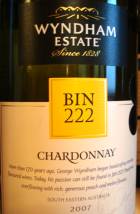 Wyndham
Estate Bin 222 Chardonnay South Eastern Australia, 2007 has tropical fruit
and rich spiced buttery tones - pineapple and melon. The palate is creamy and
ripe but with a snappy citric finish.
Wyndham
Estate Bin 222 Chardonnay South Eastern Australia, 2007 has tropical fruit
and rich spiced buttery tones - pineapple and melon. The palate is creamy and
ripe but with a snappy citric finish.
Wyndham Estate Bin 333 Pinot Noir South Eastern Australia, 2007 cherry
cola aromas with hints of earth and leather and crushed floral notes. Fine
tannins on the palate, the flavours here are leaner than expected after the
overt aromas but it has bright acidity.
Wyndham Estate Bin 444 Cabernet Sauvignon, South Eastern Australia, 2005
has aromas of currents and green peppers with smoke, bacon fat and earthy
undertones. The palate is bright, quite juicy with red fruit, spice and cocoa,
finishing with fine tannins.
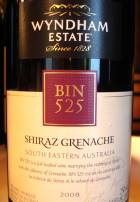
Wyndham Estate Bin 515 Shiraz~Viognier, South Eastern Australia, 2006 has
sweet cherry 'lolly' aromas and allspice with just a hint of lavender.
Bright berry fruit and lifted spice on the palate.
Wyndham Bin 555 Shiraz, South Eastern Australia, 2006 is the most popular
wine in the Wyndham Estate portfolio. Aromas of blackberries and leather, spice,
chocolate and meaty/savoury undertones. The palate is fleshy, the texture is
soft and spice lingers.
George Wyndham Semillon~Sauvignon Blanc, South Eastern Australia, 2008 is
52% Semillon and had lovely candle wax and sweet honey aromas, tropical fruits,
exotic citrus and vanilla,

tart kiwi and snap peas. The palate is concentrated with grassy, figgy flavours,
snappy acidity and lingering flavours of lemon peel.
George Wyndham Shiraz~Grenache Mclaren Vale/Barossa Valley, 2006 has
gorgeous mixed berries, licorice and allspice, lifted eucalyptus and blueberry
tones. The palate is supple, the texture creamy, its loaded with berries and
spiced chocolate with fine dusty tannins on the finish.
George Wyndham Shiraz~Cabernet, Limestone
Coast, 2006 bright cassis, menthol,
chocolate and forest berry aromas. The minty/eucalypt returns on the palate
layered with pepper and chocolate.
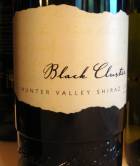
Wyndham Estate Black Cluster Shiraz
Hunter Valley, 2006 this wine has
terroir written all over it - plush dark berries, hints of red cherry and plum,
espresso, chocolate, savoury hints of bacon fat and mint. The palate is supple
and dense, the minerality pops here - slightly saline - it is focused and
elegant with dusty tannins on the finish.
For more information on Wyndham Estate
click here
Riverina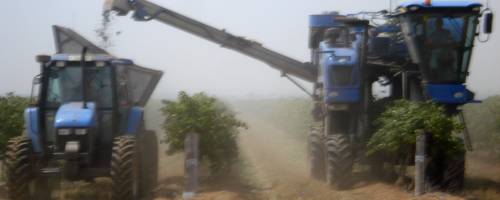
harvesting Merlot in the heat of February on a 500 acre
vineyard
Knowing little about Riverina, except that it
produces
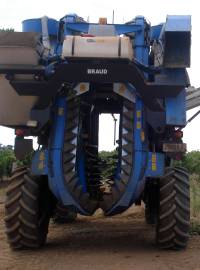
an enormous amount of juice consumed around the world, I was excited to hop onto
a small commuter plane and fly over an hour into the outback. Heading west , out
of Sydney, over the blue-green of the Blue Mountains (part of the Great Dividing
Range which runs from the northern tip of Queensland to Victoria in the south)
across kilometers of desert, out of nowhere appeared a greenbelt swaths of
water.
My day was to be spent at the home of the Aussie wine phenom - Yellow Tail. As
we circled toward the tiny Griffith Airport I noticed the tanks - large white
tanks standing like soldiers in the mid-day sun, I'd seen rows of tanks like
that before, at the giant, Gallo in Sonoma, so I was pretty sure we had arrived
in Riverina - also known as the "engine room" of Australian wine production.
From Griffith we drove to Yenda, home of the Casella family and of Yellow Tail
wines, who also happen to be the largest employer in that small town.
Yellow Tail
Yellow Tail is a wine geeks nightmare. It dumbs down wine, they wail,
it's the cola of wine they moan and turn up their nose, and the
favorite...those wines show no sense of place, no terroir....
Perhaps.
I will admit, one hundred 1.1million liter tanks are enough to scare any wine
lover, or intrigue them as it did me. How does an Italian family, who settled in
the Riverina agriculture belt, in the middle of New South Wales in the early
sixties,
go from making small amounts of wine, loading it into barrels and traveling
weeks per year to Queensland to sell it, end up with the phenomenon of Yellow
Tail? Timing, marketing, hard work and quality for the price... John Casella
says. John would often make the trip to Queensland with his father, sleeping in
the car and bathing in the rivers on their trek north to sell their wines.
He
has not forgotten those days and as a tribute, smack in the middle of the Yellow
Tail factory/winery is the original house he grew up in. It's somewhat
dilapidated and tiny but its a tribute to where the Casella's came from.
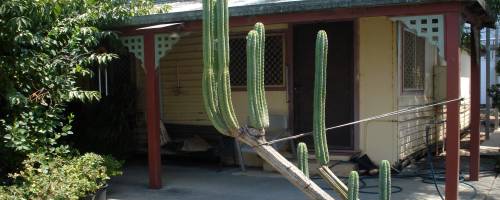
The Casella house still stands, alongside the
original winery in the midst of the massive
compound
It's hard to believe that YT was started less than a decade ago, it grew so
rapidly. The name and it's recognizable wallaby launched the "critter" phase in
wine labeling. Yellow Tail is what it is, an alcoholic beverage made from
grapes. It's affordable, unpretentious and the packaging is happy. That is not a
crime. But from my own perspective, traveling around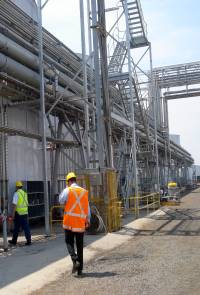 Australia and meeting winemakers and owners from large wineries and small,
there is a time for everything and a wine for everyone. Most people will
graduate from YT wines as their palate becomes more sensitive, as they become
more curious and want to learn more about wine. And trends also change more
rapidly than ever before. What goes up must come down. I found the stress among
large Australian producers was palpable. Australia can no longer rest on its
laurels and reap the benefit of juicy, fruity Shiraz, not when there are new
kids ready to knock them off their block and new flavours for consumers to
quaff. The big guys like YT realize this, sales are no longer what they were at
their peak. But, in order to keep us interested, they continue to developed new
products. Products like the [yellow tail] bubbles and the newer yet,
[yellow tail] bubbles rose as well as a new candied sweetie,
[yellow tail] Moscato that I tasted in Yenda and of course their
[yellow tail] Reserve range of more substantial, premium wines.
Australia and meeting winemakers and owners from large wineries and small,
there is a time for everything and a wine for everyone. Most people will
graduate from YT wines as their palate becomes more sensitive, as they become
more curious and want to learn more about wine. And trends also change more
rapidly than ever before. What goes up must come down. I found the stress among
large Australian producers was palpable. Australia can no longer rest on its
laurels and reap the benefit of juicy, fruity Shiraz, not when there are new
kids ready to knock them off their block and new flavours for consumers to
quaff. The big guys like YT realize this, sales are no longer what they were at
their peak. But, in order to keep us interested, they continue to developed new
products. Products like the [yellow tail] bubbles and the newer yet,
[yellow tail] bubbles rose as well as a new candied sweetie,
[yellow tail] Moscato that I tasted in Yenda and of course their
[yellow tail] Reserve range of more substantial, premium wines.
I arrived in Australia at the tail end of the February heat wave, at the same
time the fires were burning in the south, in Victoria. And, standing at the edge
of a 500 acre vineyard watching half-baked Merlot grapes being machine harvested,
I watched the smoke weave its way, from over a thousand kilometers away, across the Riverina sky. It was a hot, windy day, dust coated everything, the harvesters
were running non-stop to get fruit in before more heat damage could occur. This
was just one vineyard, of 650 growers (from around South Eastern Australia)
Yellow Tail buys grapes from, if that puts it in perspective.
If not, 2008s production was 15 million cases...
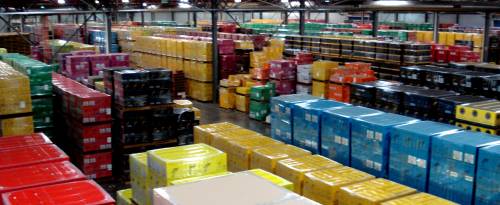
the warehouse in Yenda NSW at Casella Wines - filled
with [yellow tail]
Some recent Yellow Tail reviews on
WineDiva.ca
[yellow tail] bubbles
[yellow tail] bubbles rose
[yellow tail] pinot grigio
[yellow tail] shiraz~cabernet
[yellow tail] the Reserve Shiraz
Read about McLaren Vale
Read about Barossa Valley
Read about Clare Valley
Read about Adelaide Hills
Read about Hunter Valley, New South Wales
Read about Yarra Valley, Victoria
- end -



 After
being picked up by Brokenwood General Manager (and one of its 23 partners),
Geoff Krieger in Sydney we drove north, into this verdant coastal range until we
rolled into the town of Cessnock then continued north along Highway 82, also
known as Wine Country Drive. By the time we passed the legendary Lovedale
Vineyard there was no doubt we were in wine country as row upon row of vines
painted the horizon. Turning onto Broke Road, then MacDonald Road we made a
brief stop in the Graveyard Vineyard to taste the berries before taking the back
way into my first Hunter Valley stop, the highly acclaimed Brokenwood winery.
After
being picked up by Brokenwood General Manager (and one of its 23 partners),
Geoff Krieger in Sydney we drove north, into this verdant coastal range until we
rolled into the town of Cessnock then continued north along Highway 82, also
known as Wine Country Drive. By the time we passed the legendary Lovedale
Vineyard there was no doubt we were in wine country as row upon row of vines
painted the horizon. Turning onto Broke Road, then MacDonald Road we made a
brief stop in the Graveyard Vineyard to taste the berries before taking the back
way into my first Hunter Valley stop, the highly acclaimed Brokenwood winery. skins
into golden sheets.
skins
into golden sheets. 









 aromas,
sweet spices and dark floral notes. The palate is silky it has very good
structure with juicy red fruit, spice and cedar flavours, there are fine tannins
on the finish.
aromas,
sweet spices and dark floral notes. The palate is silky it has very good
structure with juicy red fruit, spice and cedar flavours, there are fine tannins
on the finish.





 Although
my positive experiences in Australia are to numerous to count, my visit to
Wyndham introduced me to someone who left an amazing impression on me.
Although
my positive experiences in Australia are to numerous to count, my visit to
Wyndham introduced me to someone who left an amazing impression on me.  Little
did either of us know, he going to be spending the day with me. As it turned
out, he gave me a lift back to Sydney and we ended up not only on the same
flight, but Nigel was gracious enough to take me into the Qantas Lounge with him
while we waited for out flight to Adelaide. Brave man. But I was happy to spend
the time with him and pick his brain about winemaking in Australia.
Little
did either of us know, he going to be spending the day with me. As it turned
out, he gave me a lift back to Sydney and we ended up not only on the same
flight, but Nigel was gracious enough to take me into the Qantas Lounge with him
while we waited for out flight to Adelaide. Brave man. But I was happy to spend
the time with him and pick his brain about winemaking in Australia.  Wyndham
Estate Bin 222 Chardonnay South Eastern Australia, 2007 has tropical fruit
and rich spiced buttery tones - pineapple and melon. The palate is creamy and
ripe but with a snappy citric finish.
Wyndham
Estate Bin 222 Chardonnay South Eastern Australia, 2007 has tropical fruit
and rich spiced buttery tones - pineapple and melon. The palate is creamy and
ripe but with a snappy citric finish.






 Australia and meeting winemakers and owners from large wineries and small,
there is a time for everything and a wine for everyone. Most people will
graduate from YT wines as their palate becomes more sensitive, as they become
more curious and want to learn more about wine. And trends also change more
rapidly than ever before. What goes up must come down. I found the stress among
large Australian producers was palpable. Australia can no longer rest on its
laurels and reap the benefit of juicy, fruity Shiraz, not when there are new
kids ready to knock them off their block and new flavours for consumers to
quaff. The big guys like YT realize this, sales are no longer what they were at
their peak. But, in order to keep us interested, they continue to developed new
products. Products like the [yellow tail] bubbles and the newer yet,
[yellow tail] bubbles rose as well as a new candied sweetie,
[yellow tail] Moscato that I tasted in Yenda and of course their
[yellow tail] Reserve range of more substantial, premium wines.
Australia and meeting winemakers and owners from large wineries and small,
there is a time for everything and a wine for everyone. Most people will
graduate from YT wines as their palate becomes more sensitive, as they become
more curious and want to learn more about wine. And trends also change more
rapidly than ever before. What goes up must come down. I found the stress among
large Australian producers was palpable. Australia can no longer rest on its
laurels and reap the benefit of juicy, fruity Shiraz, not when there are new
kids ready to knock them off their block and new flavours for consumers to
quaff. The big guys like YT realize this, sales are no longer what they were at
their peak. But, in order to keep us interested, they continue to developed new
products. Products like the [yellow tail] bubbles and the newer yet,
[yellow tail] bubbles rose as well as a new candied sweetie,
[yellow tail] Moscato that I tasted in Yenda and of course their
[yellow tail] Reserve range of more substantial, premium wines. 